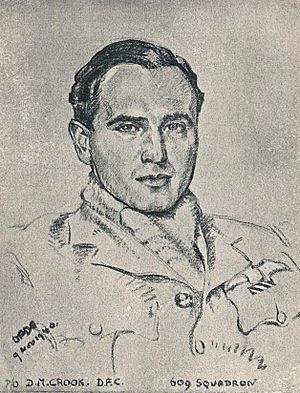David Moore Crook facts for kids
Quick facts for kids
David Moore Crook
|
|
|---|---|

David Moore Crook photographed in September 1940. Copied from his autobiography Spitfire Pilot (1942)
|
|
| Nickname(s) | DMC |
| Born | 24 November 1914 Huddersfield, England |
| Died | 18 December 1944 (aged 30) near Aberdeen, Scotland |
| Allegiance | United Kingdom |
| Service/ |
Royal Air Force |
| Years of service | 1938–1944 |
| Rank | Flying Officer |
| Unit | No. 609 Squadron RAF |
| Battles/wars | Second World War |
| Awards | Distinguished Flying Cross |
David Moore Crook (born November 24, 1914 – died December 18, 1944) was a brave British fighter pilot during the Second World War. He was known as a flying ace, which means he shot down many enemy aircraft. He also wrote a famous book about his experiences called Spitfire Pilot.
Flying with the RAF
David Moore Crook joined the Royal Air Force (RAF) when World War II began. He flew the amazing Supermarine Spitfire plane. He was part of No. 609 Squadron RAF.
He played an important role in the Battle of Britain. This was a huge air battle where British pilots defended their country from German attacks. David Crook was very skilled. He shot down several enemy planes, including German Junkers Ju 87 and Messerschmitt Bf 109 aircraft.
On one occasion, he accidentally shot down a friendly British plane. Luckily, the crew were only slightly hurt.
For his bravery and skill during the Battle of Britain, David Crook received the Distinguished Flying Cross (DFC). This is a special award given for courage while flying. The official announcement said he "led his section with coolness and judgment" and had destroyed six enemy aircraft.
After the Battle of Britain, David Crook became an instructor. He taught other pilots how to fly. He continued to serve in different RAF units.
Sadly, on December 18, 1944, David Crook was flying his Spitfire IX plane near Aberdeen, Scotland. His plane crashed into the sea, and he was listed as missing. He had just turned 30 years old. When his belongings were collected, a Bible and a copy of "The Wind in the Willows" were found on his bed.
Remembering David Crook
David Moore Crook is remembered in several places. His name is on the Runnymede Memorial, which honors airmen who died with no known grave. He is also listed on the Battle of Britain Monument in London.
A plane that David Crook flew is now on display at the Imperial War Museum in London. This helps people remember his bravery and the important role he played.
His Books
David Crook was not just a pilot; he was also a writer. His most famous book is Spitfire Pilot, published in 1942. It's an autobiography, meaning it tells the story of his own life and experiences flying the Spitfire during the war. The book included a portrait of him by a famous RAF artist, Captain Cuthbert Orde.
He also wrote a fiction book called Pursuit of Passy. This story is about an RAF pilot who crashes in France and joins the French Resistance. The French Resistance was a secret group that fought against the German occupation during the war.
David Crook's original flying log book, which recorded all his flights, is kept at The National Archives in Kew. Anyone can go and see it.
In 2021, a new edition of his memoir Spitfire Pilot was published. It included new introductions by famous historians and his own daughter, showing how important his story still is today.


